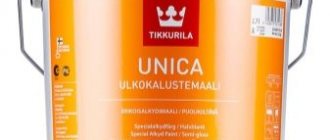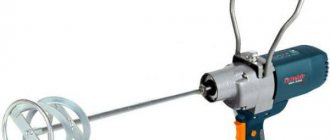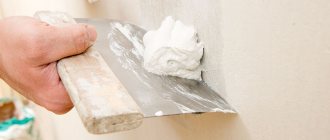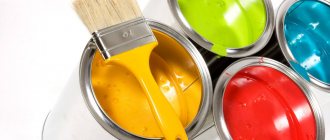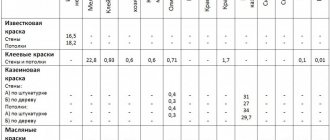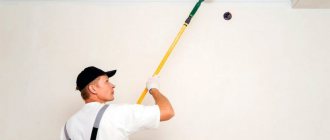At the renovation stage, you should plan future expenses in advance, for which it is important to read the volume of required materials. When performing paint and varnish work, this is the paint consumption for walls and ceilings, which you can determine yourself.
Each manufacturer indicates on the packaging the approximate coating consumption per 1 m2. The production of paint and varnish coating is influenced by the tool used during application, as well as the type of surface to be painted. By calculating the area required for processing, you can quite accurately determine the volume of paint and varnish materials when performing repairs.
Paint calculation (instructions)
Of course, today you can use special calculators that independently calculate the consumption of paint materials.
It’s quite easy to find them on the Internet; many large stores of construction and finishing materials install such calculators in their sales areas, but you still shouldn’t trust them completely. In addition, for the calculation you will still need the dimensions of the room, the intended type of paint, and surface characteristics.
Many manufacturers indicate approximate paint consumption on the packaging. So you can simply multiply the surface area by these figures.
But such a calculation will be extremely approximate, because it does not take into account the paint remaining on the equipment and the porosity of the surface being painted.
But you should still start with the size of the room intended for painting.
How to correctly calculate the area of walls with a complex surface
Not all rooms have a strict rectangular shape. Buildings often contain intricate architectural elements that complicate calculations.
How to calculate the square footage of walls minus openings
When determining the exact scope of work, we subtract the sizes of windows and doors from the total number of square meters of the walls of the room. To do this, measure the width and height of the window along the edge of the frame, and the dimensions of the door along the edge of the frame.
By multiplying the length and width of the openings, we get the size that needs to be subtracted.
We proceed in the same way if we need to exclude stoves, fireplaces, and radiators from the calculated square footage of a room.
The room has a window 2.5 m × 1.5 m and a door 0.9 m × 2.1 m.
S window is equal to 2.5 × 1.5 = 3.75 m².
Door S is equal to 0.9 × 2.1 = 1.89 m².
S walls minus openings is 54 − 3.75 − 1.89 = 48.36 m².
Determining the area of irregularly shaped rooms
To determine the perimeter of buildings of any configuration, we add the lengths of all walls, including projections and niches.
You can take measurements of irregularly shaped rooms by dividing the surface into several simple shapes.
If you have a room with a rectangular projection, you have two figures whose squaring is easy to calculate, then add.
If an element contains a semicircle, to calculate it you need to divide it into a semicircle and a rectangle.
How to count square meters of walls with round elements
There are round and semicircular residential buildings or structures with elements of windows or doors in the form of an arch.
Their perimeter can be determined by multiplying the diameter by the number π (Pi) = 3.14.
We determine the square footage of the vertical surfaces by multiplying the resulting value by the height from floor to ceiling.
S of a circle is equal to the square of the radius multiplied by the number π; semicircle - half this value.
If it is necessary to subtract the area of round columns or semicircular protruding elements from the square footage of a room, if it is impossible to measure the diameter or radius, measure the circumference (P) and apply the formula: S = P² / 4π.
How to calculate square meters of structures in the form of a triangle
If there is a room with triangular elements, we can apply several formulas, depending on the type of shapes:
Where a, b, c are the lengths of the sides of the triangle; p—perimeter.
Room volume
To determine the volume, you need to calculate the floor area and multiply the resulting figure by the height. V = S × h.
Area calculation
The formula for such a calculation is known even to primary schoolchildren:
- For the ceiling, it is the product of the width of the room times its length. In this case, the obtained result is additionally multiplied by two, since for high-quality painting it will be necessary to apply at least two layers. If the previous coating had dark tones, then when repainting it in white shades, it may be necessary to apply three, and perhaps four layers. In this case, paint consumption increases accordingly.
- For a wall, the area is calculated by multiplying the length by the height, but some walls will have window and door openings, so the footage of such structural elements is subtracted from the overall result. At the last stage, the areas of all walls are summed up if the same paint is used for all surfaces, or counted separately if the walls are painted with different colors or textures.
What to consider when making calculations
When making calculations, the following criteria are taken into account:
- room area;
- type of original surface;
- tool or method of application;
- type of paint and its basic characteristics.
Room area
To calculate the amount of paint, it is necessary to determine the area of the surfaces to be treated. To do this you will need to measure the length, width and height of the walls.
If only the walls are to be painted, then the total area of the surfaces to be painted is calculated by multiplying the perimeter by the height. Knowing the source data, all that remains is to substitute them into the formula:
P = (a+b) x 2; S = P x h.
According to SNiP IV-2-82 for finishing works, the area of window and door openings is calculated from the outer outline of the frames, and then subtracted from the area of the walls.
Surface texture and material
How many liters of paint will be used during painting depends on the type of surface.
From the point of view of tactile perception, the substrate can be of 2 types:
- smooth;
- rough.
The first is less porous, so its absorbency will be lower. It is no coincidence that the base is puttied and sanded before painting. But sometimes the relief texture becomes a decorative element.
Main surface types:
- cement-concrete (brick, plaster, cinder blocks, etc.);
- metal;
- wooden;
- plastic;
- paper
Painting concrete, drywall, untreated wood, and wallpaper for painting will require more material. Metal, plastic, primed wooden base will require less cost.
When painting metal, you will need less paint than when painting drywall.
Powder paint is often used to process complex terrain and metal structures, although its application requires special equipment (pneumatic tools and a polymerization chamber).
Good material for painting:
- small parts (machine disks, pipes);
- metal furniture (cabinets, racks);
- metal fences and stairs;
- household appliances (refrigerators, cookers, washing machines, etc.).
The paint protects against corrosion and provides electrical insulation. This composition is not used on wood and plastic, because the melting temperature in the chamber reaches +200° C. Powder paint consumption is 100-140 g/m².
Tools used
Various tools are used in painting:
- brush;
- roller;
- spray gun (spray gun), etc.
The choice depends on the scope of work. A roller and a spray gun are suitable for processing large surfaces. When painting small parts, window frames and doorways, it is more advisable to use a brush.
The spray gun uses paint and varnish most economically. The principle of its operation is characterized by a non-contact method of application. A special gun sprays the paint under pressure and allows it to be evenly distributed. An aerosol can works similarly.
To avoid paint getting onto adjacent surfaces, use masking tape. When working with spray guns, you may need a mask and goggles. Cotton gloves will protect your hands.
The spray gun uses paint sparingly.
Original surface color
The original color of the coating also matters in paint consumption. If the substrate and paint are light, it will be easier to achieve uniformity.
It is more difficult to paint over a dark base, for example, with white paint. More layers will be needed.
Careful preparation of the substrate for painting will help reduce effort and costs. If the old coating remains, it is better to remove it, sand the surface and prime it. The extra hours of repair will pay off in savings on material consumption.
Dye color
The shade of the pigment, like the color of the substrate, contributes to the cost. The density of light dye is less, so it is consumed faster. If white paint weighing 1 kg can cover up to 10 m², then the same amount of black paint will cover a space twice as large (up to 20 m²).
As an example, the table shows the dependence of oil paint consumption on color.
| Color | Surface area covered by 1 liter of paint, m² |
| Red | 5-10 |
| Yellow | 5-10 |
| White | 7-10 |
| Green | 11-14 |
| Blue | 12-17 |
| Brown | 13-16 |
| Black | 20 |
Type of composition
Depending on the composition, paints are used for interior and exterior finishing work. Some are more suitable for interior solutions, others - for updating facades.
The composition of paints and varnishes includes the following components:
- binder base (film formers);
- pigment;
- fillers (microcalcite, talc, koalin, chalk, etc.);
- additives (antiseptic, fire retardant, etc.);
- solvents (water, white spirit, etc.).
The more components, the higher the quality of the product. Paint can contain up to 20 components.
Pigment is one of the components of paint.
Covering power of the coloring composition
The ability of paint to create an opaque coating is called hiding power. It is checked visually and experimentally.
The traditional test is the “chessboard”. A substrate of squares of dark and light shades is coated with dye. At the end of the test, the base should not be visible. The difference in cell brightness (contrast ratio) will help determine coverage.
There is no need to conduct experiments yourself, because... this indicator is indicated on the bank. Depending on the manufacturer, this pigment characteristic can be expressed in g/m² or l/m².
The covering characteristics of the composition are divided into 4 covering classes:
- 1 class (overlapping ability – 99%);
- 2nd grade (98-99%);
- 3rd grade (95-98%);
- 4th grade (below the 95% mark).
Buying paint with a low hiding power will not save money. And not all manufacturers put such markings; they often indicate only the consumption of the composition for a particular surface. In this case, the spread in the range of indicators will be significant.
Dry residue
The solid paint layer that remains after the base has dried (the volume of non-volatile substances) is called dry residue. The higher the number, the more environmentally friendly the material is, meaning it contains fewer solvents (volatile organic compounds, or VOCs). The use of paints and varnishes with low solids levels may increase the concentration of ozone in the atmosphere. All this has negative consequences for the health of people and animals. The development of respiratory diseases is especially dangerous.
The table shows the values of non-volatile substances.
| Dry residue indicator | Percentage content, % | Thickness of 1 layer, microns | Optimal number of layers | Environmental impact |
| Low (LS) | 40 | 20 | 3-4 | Negative due to high content of volatile substances |
| Average (MS) | 50 | 30 | 2 | Moderate exposure, less volatiles |
| High (HS) | 60 | 10 (the second is applied 40 microns thicker) | 1,5-2 | Minimum |
| Ultra High (UHS/VHS/HD) | 80 and above | 5 (first layer – thin; second – thick, up to 50 microns) | 2 | Minimum volatile substances |
Today, it is prohibited by law to produce products with low residue levels. The material costs in this case turn out to be unreasonably high, not to mention the environmental consequences. To achieve optimal coating thickness, up to 4 layers are required.
The most environmentally friendly materials are labeled “Low VOC” (minimum volatile substances). But also from a practicality point of view, paints with high residue rates are able to cover a larger surface. In addition, the low solvent concentration allows for fewer layers to be applied. In this case, even 1 layer will be enough to form a durable film.
Today in Russia the production of paints with low solids is prohibited by law.
Dye Density
Density is calculated using the formula: p = m/V, where m is the mass of the substance, and V is its volume.
For different types of paints and varnishes, the density varies from 0.9 to 1.6 kg/m³. For example, for PF enamel this figure is 0.9-9.2 kg/m³, and for acrylic paint - 1.45-1.55 kg/m³.
The density of the dye also depends on external factors (air temperature, pressure, humidity level) and the mass of the color pigment.
Coloring tools
There are several ways to apply paint:
- An economical spray gun wastes virtually no paint. It can be used to treat any large surface area.
- A brush will increase paint consumption by about 10-15%. It is preferable to use this tool to process surfaces that do not have a large area, as well as objects with a complex geometric configuration.
- Rollers will require an increase in the calculated amount of paint by 10-12% depending on the length of the pile. They will bring maximum benefit on flat, wide surfaces.
How to correctly calculate the area of walls with a complex surface
Most walls are not a perfect rectangle. The structures contain protrusions, pilasters, and beams or ceilings may protrude from the ceiling.
Determining the area of irregularly shaped rooms
To correctly calculate the area of a complex room, you need to divide them into rectangles and then sum the results.
How to count square meters of walls with round elements
Semicircular projections are rarely found in the architecture of private buildings, but such buildings still exist. If the cylindrical element acts as a balcony or bay window, then you can use the formula for perimeter and height.
We calculate the main part of the room using the formula for the perimeter of a rectangle, then determine the perimeter of the circle and divide it in half.
Ppo = Po/2 = 2π*R/2 = π*R
Po – circumference of the circle
Ppo – semicircle perimeter
R – radius is the distance from the center to the circle. In fact, to do this you need to measure the width of the opening and divide this number by two.
Cylindrical elements do not always have the shape of a regular circle; in some cases it is necessary to determine the perimeter of an ellipse or its individual sector.
a, b – semi-axes of the ellipse
Then we add this value to the perimeter of the walls of the rectangular part of the room.
Spo – area of half a circle
Sav – area of the rectangular part of the window
How to calculate square meters of structures in the form of a triangle
There are no triangular rooms, but such a silhouette can be created due to the slopes of the pitched roof on the attic floor. First, we divide the wall into rectangular and triangular parts. The area of the triangle is calculated using the formula.
a – base of triangle AB
Let's calculate the area of the walls using the example of the attic floor of a house with a gable roof.
Calculate the perimeter of the room
We calculate the height by the side of the rectangle, and not by the height to the ridge. We get the area of the walls up to the Mauerlat.
Mauerlat is a timber that is laid on the wall. The rafter legs rest on it.
S1 – area of rectangular sections of walls
S2 is the area of the triangular section of the walls up to the rafters.
The calculation will be different for a house with a pitched roof. These types of roofs are often found on extensions and garages. In this case, the area between the rafters and the Mauerlat line is calculated using the formula for a right triangle.
a is the length of the slope to the wall.
b – the height of the wall from the roof to the Mauerlat line.
How to calculate square meters of structures in the form of a trapezoid
a is the width of the upper part of the wall.
b – width of the wall at the level of the mauerlat.
h – the height of the wall to the Mauerlat line from the top point.
Color
Paint consumption also depends on the chosen color:
- The maximum amount of material will be required when choosing white and pastel shades (a kilogram of paint is enough for 6-10 square meters);
- Yellow and red tones will color approximately the same area;
- Green paint will cover 10 to 14 squares;
- 11-17 meters can be decorated with blue;
- Brown paint will help to finish 12-17 meters;
- Black color will fit comfortably on 17-20 squares.
How to calculate wall area
To estimate the estimate and volume of purchases before starting finishing work, you need to know the footage of the walls. The consumption of most building materials (paint, plaster, putty) is determined by the area. This parameter is also important when searching for crews, since most finishers estimate work by cost per square meter.
how to glue tiles to the floor in a bathhouse
Types of paint
The type of paint used is also important. The approximate consumption of each of them is usually indicated on the can.
Oil paint
The standard consumption is 150-250 grams per square meter, but it is worth considering that this figure is calculated per kilogram of material, and paint is measured in liters.
- Before use, it is recommended to dilute oil paint a little: undiluted paint is thick, forms unsightly growths and is wasted a lot.
- But paint that is too diluted will not bring pleasure either: it flows, paints poorly, leaving the previous finish visible.
Oil paint is usually applied in two layers, allowing the first layer to dry completely. The second coating will require much less consumption, since it will be applied to a smooth surface without pores.
Water-based paint
The popular paint perfectly decorates walls and ceilings, holds well and lasts a long time. Additional advantages are the absence of odor, ease of application, and durability of the created design.
When special additives are added, the paint begins to withstand high humidity well, so it can be used in almost any room.
The consumption coefficient of such paint varies from 9 to 11 square meters of surface per liter. This figure can be increased if the paint is slightly diluted with plain water.
Acrylic paint
Another reliable and attractive coating will cope with painting any surface. The standard consumption is considered to be one liter per 8 square meters. In reality, this figure is somewhat less, so it is better to focus on painting 6-7 meters.
The paint is used in several layers, each subsequent level requires about a third less paint.
Alkyd paint
For this type of paint material, the consumption is set at 150 grams per square meter; a liter should be enough to process 10 squares.
Such paints have a high hiding power (overlapping the previous finish) and bright colors, so that one layer is often enough for a high-quality design, which significantly reduces consumption.
Some tips
When painting walls and ceilings, it is important to wait until all layers are completely dry, use the type of paint that is most adapted to the existing surface, use economical materials and suitable solvents. In this case, you can not only save on paint, but also create a beautiful and even design.
And yes, to be sure, it is better to purchase an additional 15% for unforeseen situations.
Ways to reduce paint consumption
Several examples of how to reduce the volume of paint and varnish products when finishing walls are already given above in this article. A paint roller is more suitable for painting the interior, since when using this tool, water-based paints are consumed more economically than with a brush. It is worth monitoring the degree of dilution of the original consistency, taking into account how porous, loose or heterogeneous the base is.
There are several proven ways to reduce paint consumption:
- Priming with primer paint. Universal and specialized primers strengthen the surface, increase adhesion and waterproofing parameters of walls. Water-soluble layer-by-layer impregnation must dry completely before applying a decorative paint layer. The low cost of primers compensates for the overall costs of repairing premises, since less water-based emulsion is required. This method is suitable for brickwork, mineral plaster, plasterboard, and concrete surfaces. We recommend using ODISSEY acrylic primer paint.
- Preliminary application of paint diluted by 50% . A more liquid acrylic consistency thoroughly saturates the treated area, replacing the primer. After drying, a final water-soluble coating is applied, which is less absorbed into the prepared base. It is better not to use this method when painting metal for the first time. In these situations, a special primer with anti-corrosion characteristics will be required. When decorating wooden products, it is also better to use primers with antiseptic and antifungal components.
- Thin the paint with water up to 10% . Modern paints and varnishes have the necessary fluidity and hiding power. Additional dilution is suitable for painting with a spray gun to eliminate multiple smudges. If light paint is applied to a darker base, then dilution will have the opposite effect, since you will have to add another layer. This will lead to higher repair costs.
The information above answers the question: how to calculate paint consumption for walls. And the store’s in-house consultants are always ready to help in order to correctly calculate the amount of enamel or water-based emulsion to update the interior.
The mentioned methods for calculating the required volume of paintwork can reduce repair costs, save time on delivery and coloring. It is necessary to take a balanced approach to ways to save paintwork so that savings do not result in a decrease in the performance characteristics and durability of the finish.
Photo of the best paint for walls and ceilings
How to use the calculator?
In order to calculate paint consumption using an online calculator, you need:
- Indicate the area of the working surface.
- Type of paint.
- Click the “Calculate” button.
Fuel consumption calculator, how to calculate the cost of a trip
Calculation of drywall for walls: calculator, formulas
Engine oil consumption calculator
Brick and mortar consumption calculator for masonry
Grout consumption for tiles per 1 m2 - calculator, calculation formula
Calculation of plaster and putty - consumption rates and calculator
Why do you need to count?
Many people don’t like to count and buy paint back to back, counting on further thinning of the enamel or saving it during the painting process. Practice shows that purchased liquid is not always enough. I have to go to the store for the same paint, but it’s no longer there. As a result, you are forced to repaint the entire surface in a different color, and this is an additional expense. The second option is to buy with a reserve. But such a decision can hardly be called justified due to additional costs and budget overruns. But the money spent could have been spent on more useful and necessary work.
Online calculator to help
You can only check what you calculated yourself using a special calculator. The advantage of such a program is that with its help additional operating conditions are determined. It is possible to calculate the required volume of material that will be required in the case of different surfaces, be it plaster, concrete, wood or metal. In addition, online calculators available on the Internet allow you to determine the consumption of different types of paint (acrylic, water-based, silicone, latex, etc.).
To calculate, just enter data on the size of the room in the calculator, select the type of paint and type of surface.
>Go to calculator<
Original color and surface texture
The original color of the walls being treated is of great importance. For example, if you want to refresh a wall that is painted white, then one light coat will be enough. But if the new color is dark, you will have to paint it twice.
Next, it is important to know what “paint hiding power” is. In short, this is the ability of a material to cover the color of the base when applied uniformly in a single layer.
Hiding ability is the ability of a pigment or pigmented paint and varnish material, when applied evenly to a surface, to make the color of the latter invisible or, in the case of application to a black and white surface, to reduce the contrast between black and white areas of the surface until the difference in lightness between them completely disappears.
The greater the hiding power, the better the new paint covers the color of the old one; accordingly, the better the hiding power, the more economical the use.
Is it possible to save money?
First of all, trust a professional team. It's not as expensive as it seems, especially compared to the cost of materials. As for the paint, it is better to prime the walls once again; the base should be without flaws. The best option before painting is clean, smooth walls.
Covering walls with plasterboard also saves on paint. However, in this case, the savings will be obvious when painting again, for the reason that the first time the costs are spent on leveling with plasterboard.
Calculating the paint composition before carrying out work allows you to find out the amount of costs without unpleasant surprises in the future. It is important to understand that even one classification of paint from one manufacturer may differ, and therefore purchasing in one batch will save both time and money in the future.
Examples of paint calculations per 1 square meter of surface
If one wall is 5 meters long, the other is 6 meters, add it up and multiply by 2, the perimeter of the room is 22 meters.
To get the area of the surface to be painted, multiply by the height of the ceilings - 2.5 meters. In total, it comes out to 55 sq.m. total area. The next step is to subtract the windows (0.7 m * 1 m; 0.7 m * 0.9 m) and the door (1.5 m * 0.6 m), the working surface for painting is 52.77 sq.m. The paint is applied in two layers, so you can multiply either the number of square meters or the number of cans by two.
When using economical paint for interior walls, with a consumption of 0.12 liters per sq.m., we multiply this figure by the number of meters and get a rounded figure of 12.7 liters. Based on these calculations, you should buy 13-14 liters of paint.
About paint and varnish consumption standards
In order to correctly calculate the number of square meters of surfaces to be painted, the calculation should take into account not only the application of the formula, but also that a liter of paint and varnish is used to paint different numbers of squares for different substrates, for example, the calculated data are as follows:
- 15 m2 – for metal;
- 16 m2 – for a newly plastered wall and sanded wood;
- 10 m2 – for wallpaper with a relief pattern;
- 8-10 m2 – for untreated wood;
- 15-17 m2 – for a primed plaster surface.
It is important to consider that when using material, a direct dependence on the application method, for example, with a spray gun or brush, plays a role. In the latter case, paint consumption will be slightly higher.
